Introduction
New for the 2019-20 season Blizzard completely revised its ZeroG lineup releasing all skis in the lineup with new molds, new construction, and in three widths. For review, Blizzard provided the ZeroG 105 ski in 180cms length. To recap, the ZG105's predecessor (released in 2015) was the ZeroG 108 touring ski. The ZG108 was an instant cult-classic. It was reasonably light, mid-fat, stiff, relatively straight and rewarded aggressive skiing; truly transcending the one-ski-to-do-it-all bullshit that marketers constantly spin. People loved the ZG108; it made me a Blizzard fan-boi.
The ZG108 made few concessions to user error. By contrast, the new Blizzard ZeroG 105 reviewed here upholds the virtues of the ZG108 while tweaking tip, tail and rocker profile slightly to bring out different aspects of the ski. Bliizzard cult-members can rejoice in that the ZG105 still has the aggressive bones of its predecessor but still has enough forgiveness that user error is not corrected by a series of tomahawks.

SPECIFICATIONS
The Blizzard ZeroG 105 is manufactured in lengths of 164, 172, 180 and 188 cms. I am reviewing the 180cms length which has a sidecut of 134-105-120 and a turning radius of 23m. The skis weigh 1555 and 1557g per ski. This is frankly ridiculously light! It is also fairly close to Blizzard's stated weight of 1550g per ski.
Other specifications are as follows:
- Straight pull measurement 179.1cm
- Measured tip-to-tail length 180.1cm
- Stated Dimensions: 134-105-120 mm
- Measured Dimensions: 134-104.8-1119.6 mm
- Measured Traditional Camber Underfoot: ~3 mm
- Core: Paulownia wood + laminated Carbon Fiber
- Stated sidecut radius: 23mm
Rocker pictures are in the ZG108 vs 105 comparison.
- Tip splay 34cms from tip
- Tail splay is 22 cms from tail
- Mount is -7cms from ski centre
The ZG105's manufacturing process uses a new "Carbon Drive 2.0" frame. Like the predecessor ZG108's "Carbon Drive" the manufacturing process is a framework of woven carbon sheets laminated and wrapped around a wood core. The carbon wrap is positioned in 3 dimensions with the loads theoretically arranged to tune for stiffness yet lightness.
The older ZeroG manufacturing (including the ZG108) borrowed heavily from Blizzard's alpine line so leaned towards alpine needs. By contrast, Carbon Drive 2.0 was ground-up designed for the touring market with the emphasis shifted towards weight and softer-snow considerations; carbon layups have been altered accordingly. The new carbon layer doesn’t span edge to edge across as much of the ZG105's tips and tails. This is purposeful design to make the skis a bit more playful and easy to release in fresh snow. Also added to the ZG105 are edge-to-edge, bi-directional carbon plates under the binding mounting area to add pullout resistance for binding retention and stiffness for power transfer underfoot.
The principles of Blizzards' design still remain the same; "3D" and "frame". "3D" refers to the construction method of wrapping the ZG105s tips and tails in a 3-dimensional carbon weave shape as opposed to a unidirectional carbon sheet sometimes laid in one direction on something like the ski's topsheet. "Frame" refers to the method of running the 3D carbon weave along the entire running length of the ZG105 to bridge the tip and tail area in order to attempt to control the skis' longitudinal and torsional flex, thus framing the ski.
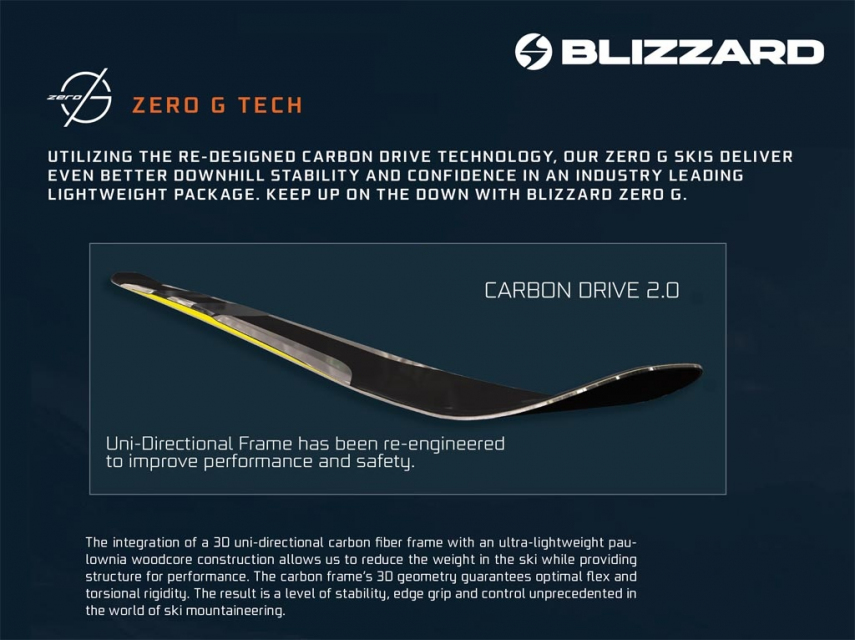
Carbon Drive 2.0 marketing
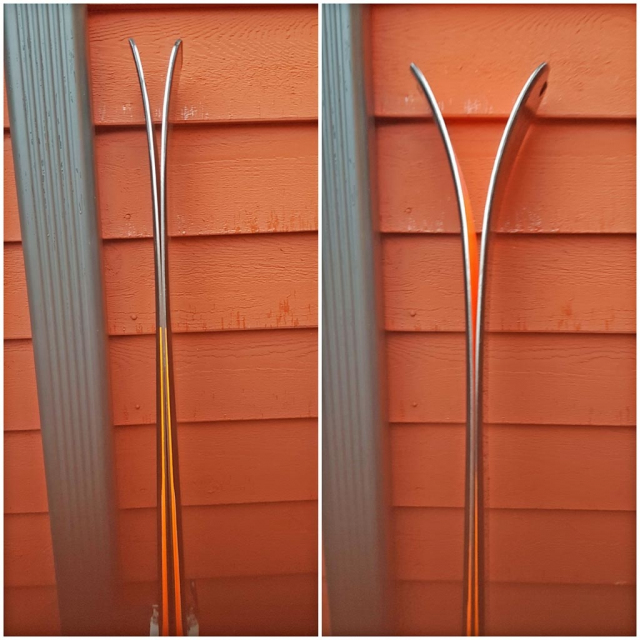
ZeroG 105 tail and tip splay

ZeroG 108 tip and tail splay. There is noticeably more tip splay on the 105vs 108 and slightly more tail splay. Mid-ski camber is very mild with both skis eyeballing the same
ABOUT THE REVIEWER
The ZeroG 105 ski was mounted with the Marker Alpinist 12 binding and has been used in a mix of conditions over a period of 38 days with almost all of the days spent in backcountry of Whistler, the Duffey and ion the BC Interior. Bindings were mounted on the recommended line. I’m not huge at 78kgs, 160 lbs, but do spend 90+ days a season skiing, with most of the days in the backcountry. My skiing is usually in high moisture-content snow. Accordingly, my preference is for bigger skis and relatively stiff boots.
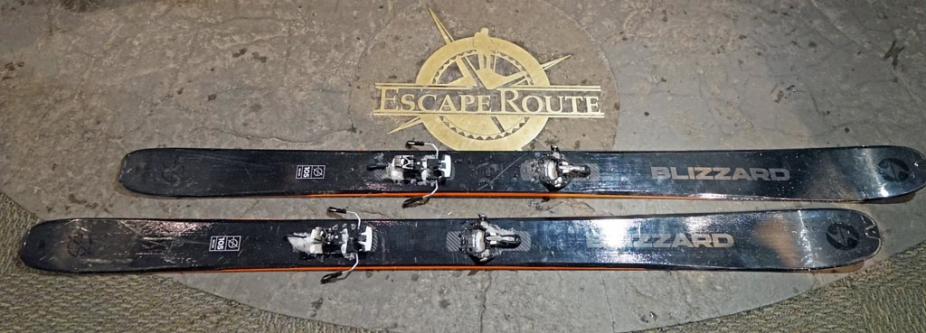
Note that the production ZeroG105 will have blue-red topsheets. Pre-production black topsheets depicted. Just a plug to support your local shop - Whistler's Escape Route
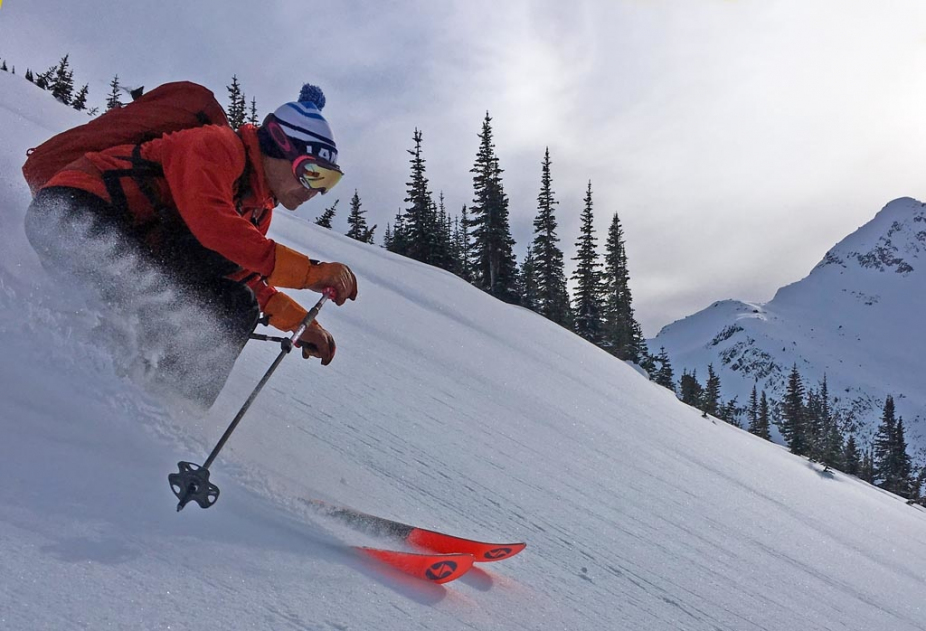
ZEROG 105 PERFORMANCE - POWDER
For powder skiing the ZG105 was very good for all but the deepest days and only being overwhelmed at balls out speed. Blizzard's tweaks to the ZeroG tip-splay seemed to help in particular with float. This was quite apparent in deeper snow (think more than 30cms of low-density snow on 40 deg slopes). In that situation, compared to the ZG108, the newer Blizzard ZG105 requires much less body english. In deeper snow the ZG108 required old-school dolphin bouncing motions to release the tips. This was much less with the ZG105 which releases quicker allowing you to ski quieter through deep snow.
However, reviews(and reviewers) must be objective and try to put negatives into perspective. I did find the ZG105s limits when I was scoped out chutes and steeps on the trees and (a couple of days after the storm) skied them. In one run I had to straightline about 10m down a chute into a massive powder bowl. I came out hot, turned away from my sluff and submerged the ZG105 tips promptly tomahawking down the powder field. A reasonable conclusion is that I have to be lighter on my feet, or that the ZG105 may be undergunned for deep powder skiing..
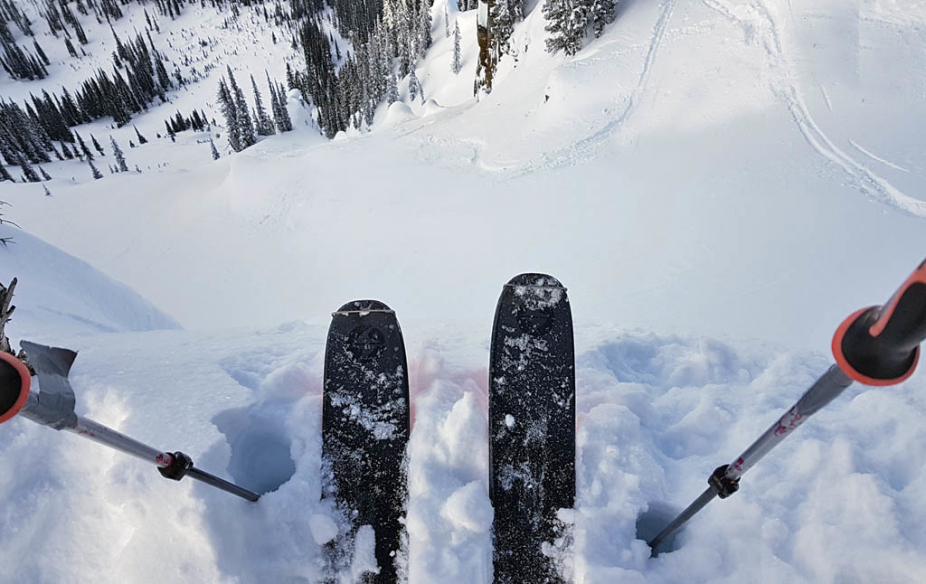
A field of powder in the Sol Mountain Lodge tenure requiring aggressive alpine skiing (after you take off your skins)
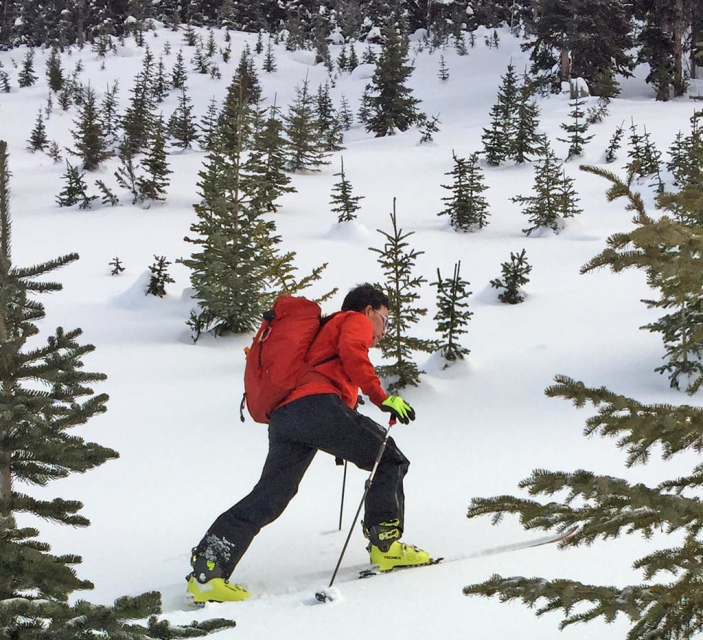
Touring for powder in the Duffey
ZEROG 105 PERFORMANCE - VARIABLE AND HARDPACK
What i really liked about the ZG108 is when I skied like an absolute idiot. I could behave like a moron running out from a fast pow line into avalanche debris or raging way too fast for my limited skill set down a tree line into a tight alder close-out where I'd be in uh-oh trouble and yet the ZG108's stability would get me out of trouble. I mean who doesn't get over their head every now and then? Despite keyboard-speculation that the new design of Blizzard ZeroG105 would result in detraction of stability I found that I could indeed ski like a complete idiot and not die because my skis folded.
My first assessment of the ZG105's ability to handle variability happened in the first few days I had the ski. On a tour behind Blackcomb the wind had put a bit of windskin and even windslab at alpine ridgelines but deposited powder into bowls so there was variability. That's where the ZG105 came into its own displaying a wide comfort range. One example where I had to drop into a SE 40 deg face where there was a bit of a windslab crust at the top requiring jump turns to unweight and displace crust to link the turns. Midway in the face I could then ski without the jump turns by driving the ZG105's tips and powering through a thin windskin. Then lower in the face the snow turns blower and I see a small windfeature off to the side in untouched fields of unicorn tears fairy dust pow. Aim at it and stuff the tips first then break the tails loose getting sideways and trying my best (but of course failing) to be as steezy as big-mountain snowboarders. But the ZG105 felt stable yet playful and totally under control.
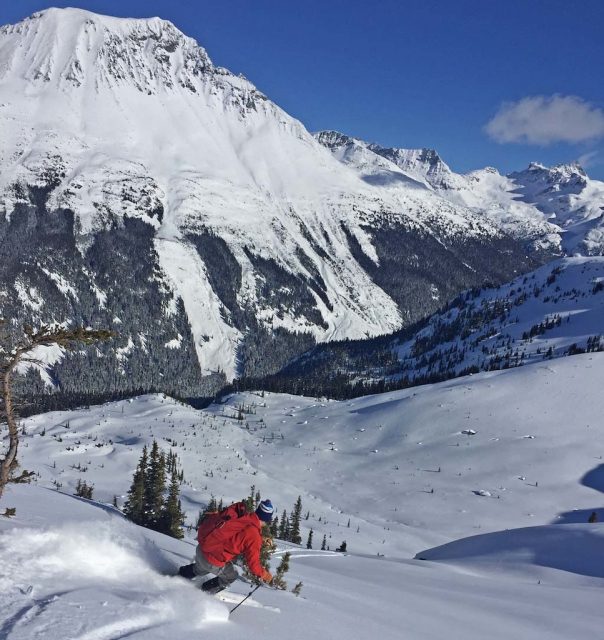
Variability invariably involved hardpack. Exits from touring locations usually involve getting through boilerplate. Alpine tours can have firm snow. Slackcountry tours can start on groomers. In those situations I am happy to report that the ZG105 is still as torsionally stiff and felt as stable as its ZG108 predecessor.
In firm steep-skiing situations the ZG105 was confidence-inspiring feeling predictable and having good edge-hold. Flat tails in particular are good for sawing back and forth in skinny couloirs or using as pickets or snow anchors. Change your balance fore-aft and you can accelerate the ZG105. Lay them over at speed, and they don't fold. In hardpack the ZG105 wants to be skied aggressively. However unlike the ZG108 which really was at its best at moderate to long radius turns the ZG105 can be bum-wiggled into tight turns; useful for bumped-out exit runs or alder-sanctioned low-elevation backcountry exits. Unlike its ZG108 predecessor the ZG105 is a bit more user-friendly for tight trees at slow speeds
Having said that a caveat. The ZG105 is a light ski. Light skis get tossed around. They simply don't have the damping qualities of heavier skis. If you're hoping to use the ZG105 as a one ski to do it all for powder situations where the powder gets skied out and cut up into variable snow and then hardpack be warned that this will get fatiguing. The ZG105 gets tossed around and your legs will have to do the work of shock absorption. The skis don't really lend a whole lot of help; which I feel is the nature of a light ski such as the ZG105
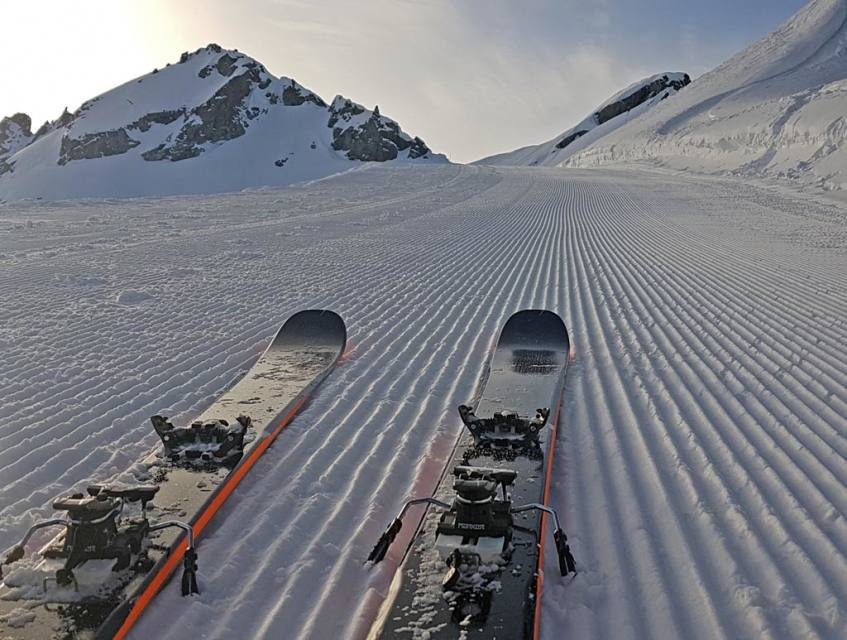
THE BOTTOM LINE
The ZeroG105 became my go-to ski for most touring situations. To expand further; my philosophy is that all touring gear is about compromises; or in other words you can't have it all. This year's weather in B.C. usually had good snow up high degrading to poor snow on lower elevation exits. This meant that you needed a ski that could do all things (long big-mountain look-at-me turns, medium radius turns, short janky Scott Schmidt style turns) to handle all the incredible variable conditions from top to bottom. This is why the ZG105 was the ski that I pulled off the rack the most. It was hard to find a place where it didn't handle this variability with confidence.
Armchair speculation to the contrary the ZG105 is not a dumbed-down version of the ZG108. It's still stiff; it still can blow through powder and variable mank. Head-to-head in boot-top to knee-deep pow I couldn't tell much of a difference between the ZG108 and ZG105. However, in deep powder my opinion is that Blizzard achieved its goal of improving deep powder performance for the ZG105. The ZG105 can still lay a (reasonable) edge on hardpack. Contrary to the skis's specs (namely the lighter weight and turning radius) the Blizzard ZG105 is still a ski meant for aggressive skiers so more laid-back ride-the-tails skiers should stay clear.

What's different in this whole package is user-friendliness. Carefully contrast this with dumbing down where a ski's feel gets neutered and one is left with an overall meh and blah feeling after your laps. The ZG105 still has lots of pent-up aggression. But with the case of the predecessor ZG108 there wasn't a whole lot of room for error. Tweaks to the ZG105's tip and tail shape have introduced an element of play. Now by no means does this mean that the ZG105 is for landing fakie or going sideways at 100kmh down some powder spines. It does mean that these ZG105 tweaks result in you having more turn shapes options simply by playing with weight-balance.
If you're the kind of skier who can lean hard into turns and get aggressive in challenging terrain and want a moderately light, touring-oriented ski to reward technique you should be looking at the Blizzard ZeroG 105. Available in limited numbers through the 2019-20 season the ZeroG105 will be priced at USD 850.
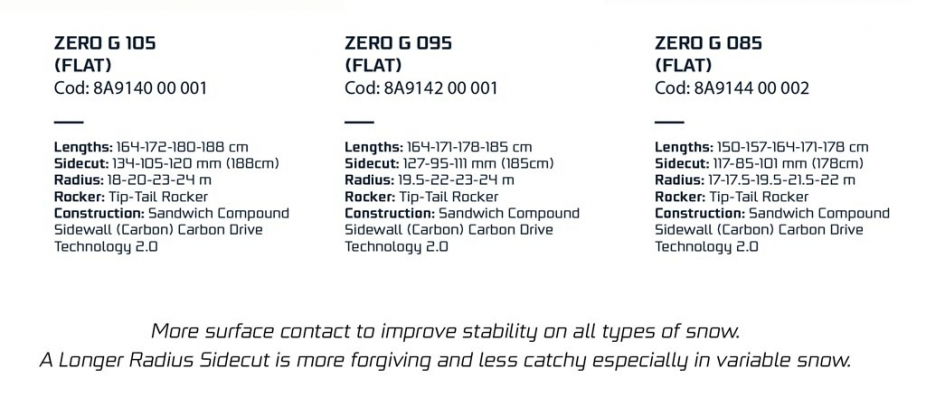
Other skis, dimensions and lengths in Blizzards' ZeroG lineup


Comments